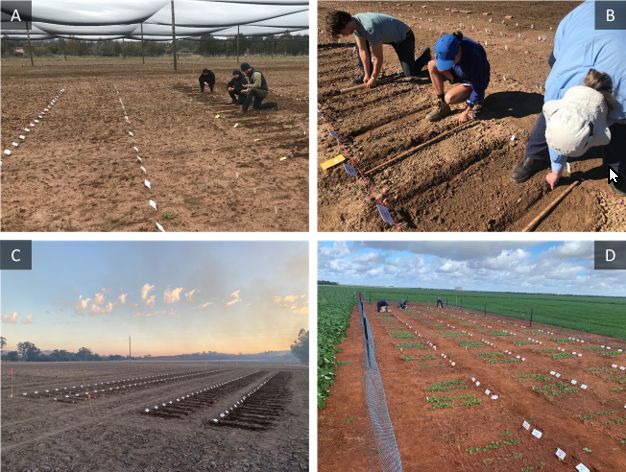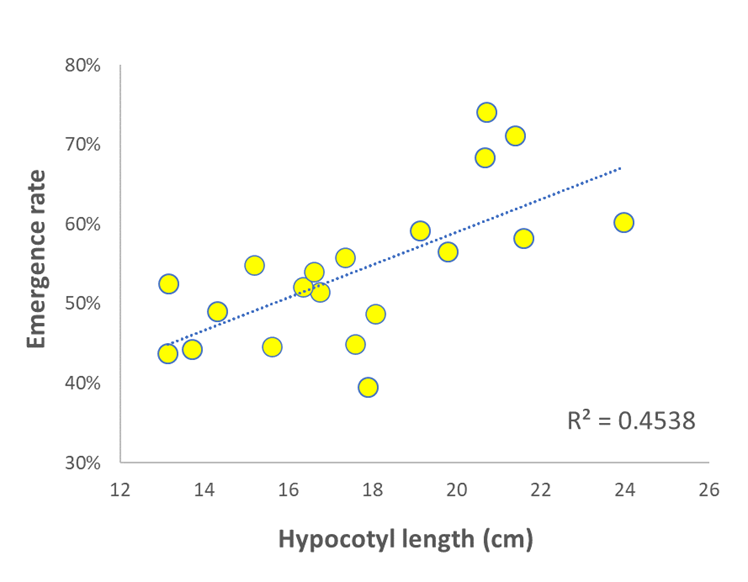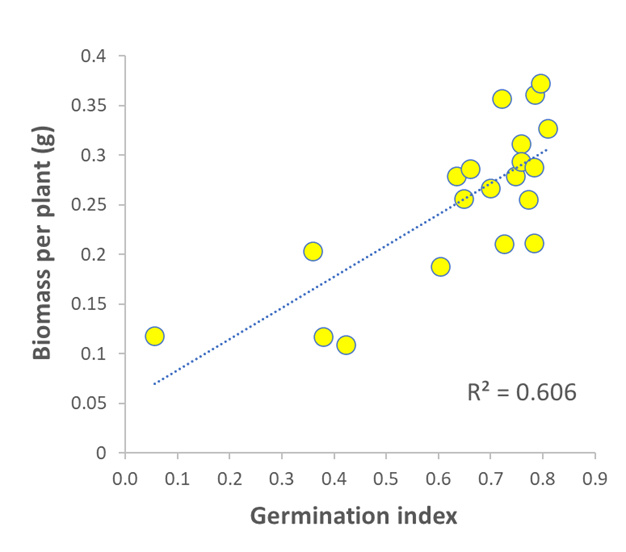New genetics for improved canola establishment
Author: Matthew Nelson, Jose Barrero, Mark Cmiel, Andrew Fletcher, Ian Greaves, Trijntje Hughes, Andrew Toovey, Karen Treble, Alec Zwart, John Kirkegaard, and Greg Rebetzke | Date: 28 Feb 2023
Key messages
- We identified international canola varieties with longer hypocotyls and greater vigour than current Australian varieties, which we predicted would establish better in the field.
- This was confirmed in field experiments in Western Australia and New South Wales in 2021 and 2022, where the best field establishment from deep (50mm) sowing depth was achieved by international varieties with long hypocotyls and/or high early vigour.
- Genetic analysis revealed that hypocotyl and early vigour traits are each controlled by several genes.
- The next step will be to transfer long hypocotyl genes from international varieties into vigorous Australian canola varieties to improve their establishment potential and suitability for deep sowing.
- To improve the genetic potential of canola to establish effectively
Aims
Introduction
Canola (Brassica napus L.) grain production provided an average of $2.7 billion per annum to the Australian economy over the past five years and the 22/23 season is projected to achieve record production of more than 7M tonnes (ABARES Australian Crop Report, December 2022). Canola also brings significant economic benefits as a break crop in cereal-based rotations by breaking disease cycles and enabling the control of weeds. In Australia, the typical crop establishment rate for canola is ~50% of germinable seed (McMaster et al 2019). This represents significant seeding cost to growers especially for hybrid varieties. Poor establishment reduces crop biomass, yield potential and competitiveness with weeds. As canola is sown increasingly early and often into warm, dry soils, we need to improve the genetic potential of canola to establish effectively under these challenging conditions.
In 2019, CSIRO and GRDC co-invested in a four-year research project (CSP1907-001RTX) to improve the genetics of canola establishment. After consulting with industry and reviewing the international scientific literature (Nelson et al 2022a), we identified long hypocotyls and early vigour as promising target traits for genetic improvement. We designed a set of lab- and field-based experiments to search for genetic diversity for these traits and to test their impact on canola establishment. We previously reported initial lab and field results (Nelson et al 2022b). Here we confirmed in a second year of field trials that long hypocotyl and early vigour traits in international open-pollinated varieties are associated with improved establishment when canola is sown deep. We also gained our first insights into the genetic control of these traits and their potential to be introduced into future canola varieties for Australian growers.
Method
Diverse canola germplasm
For any breeding activity, it is essential to have genetic variation for target traits. In our update in 2022, we reported the screening of 100 diverse international varieties comprising mainly canola-quality oilseed types but also including rapeseed, vegetable and fodder types (Nelson et al 2022b). Here, we added a further 155 varieties. This combined set of 255 open-pollinated (OP) varieties originated from 21 countries representing the canola growing regions of Europe, Canada and China, and included 101 historic Australian varieties or breeding lines. To achieve uniform seed quality and minimise maternal effects on seedling performance, seed was multiplied in the same field production site at the Ginninderra Experimental Station, Canberra in 2019. For benchmarking purposes, we also tested seedlots for 28 current commercial Australian varieties (26 hybrid and 2 OP) provided by breeding companies.
Hypocotyl and vigour traits
We previously reported the development of highly efficient and reproducible lab-based methods for phenotyping populations for hypocotyl length and cross-sectional area when grown in darkness, and seedling vigour at three stages (germination, cotyledon and 4-leaf stages; Nelson et al 2022b). These methods were used to screen the 255 international varieties and 28 current Australian varieties. For post-germination traits, seed weights were tightly constrained to minimise the influence of seed size, which was further controlled by recording the weights of each individual seed tested and using these as co-variates in subsequent analyses.
Confirming the role of long hypocotyls and early vigour in successful canola establishment
A subset of 20 international varieties was selected to include the extremes for vigour and hypocotyl traits along with five current Australian varieties. These 25 entries were evaluated for establishment from two depths (20mm and 50mm) at four field locations in 2021 (Bejoording and East Kokeby in WA, and Boorowa and Griffith in NSW; reported previously by Nelson et al 2022b) and four locations in 2022 (Fisher and Hillside in WA, and Boorowa and Griffith in NSW). Fifteen seeds were sown precisely by hand with 60mm separation in 1.2–1.5m rows at 20mm and 50mm sowing depths, with four replicates in a randomised, split-plot design (Figure 1). Field sites were visited on average 10 times each, with photographs taken of each plot which were used to track emergence counts at each sampling date. When most of the 20mm depth plants reached the 4–leaf stage, the rows were individually harvested, biomass measured and expressed as dry weight per plant. ASREML-R software (Butler et al 2017) was used to calculate best linear unbiased estimates (BLUEs), analysis of variance (ANOVA) and repeatability of traits per site.
Genetic control of hypocotyl and vigour traits
The high reproducibility of hypocotyl and vigour phenotypes in varieties pointed to strong genetic control for these traits. We investigated trait genetics further through a genome-wide association study (GWAS). The 255 international varieties were genotyped at 146,749 single nucleotide polymorphism (SNP) sites and genetic structure assessed using principal component analysis (PCA). Tassel5 software (Bradbury et al 2007) was used to identify regions of the canola genome controlling hypocotyl and vigour traits. The effect of population structure was controlled using the first two principal components of the PCA. Results were graphed in Manhattan plots.

Figure 1. Illustrative images from the Boorowa (A, B), Fisher (C) and Griffith (D) field experiments in 2022. Each seed was placed carefully in a specified position at 20mm or 50 mm depths, and then monitored until the fourth leaf stage. Photo credits: John Kirkegaard, Greg Rebetzke and Andrew Toovey
Results
Hypocotyl and vigour traits
The 255 international canola varieties exhibited broad diversity in their hypocotyl and vigour characteristics. Hypocotyl lengths ranged from 61.2mm (a European swede variety) to 232.9mm (a Canadian spring rapeseed). Australian varieties tended to have shorter hypocotyls compared to varieties from other countries. The best historic Australian variety (TawrifficTT, with 198.8mm hypocotyl length) was ranked only 24of the 255 international varieties. Furthermore, all 28 current Australian varieties had shorter hypocotyls (129.7mm to 190.6mm), although it should be noted that seeds for current varieties were not produced in the same common garden conditions as the 255 international varieties and because of this genetic and maternal (seed source) effects would likely be conflated.
One form of early vigour – seed vigour measured by germination index – also varied widely among the 255 international varieties ranging from 0.046 (an historic Australian variety) to 0.876 (an Indian rapeseed variety). Australian historic varieties were generally well represented in the high range of vigour with two of the top five most vigorous varieties being Australian. Similarly, several of the 28 current Australian varieties were almost as vigorous as the best international varieties.
In summary, many Australian varieties – past and present – had good levels of early vigour compared to international varieties but short hypocotyls. This may limit the ability of Australian canola varieties to emerge successfully from deep sowing.
Longer hypocotyls and early vigour improve canola establishment
All four field experiments in 2022 provided good quality data for emergence (repeatability ranged from 0.79 at Hillside to 0.85 at Fisher) and biomass per plant (repeatability ranged from 0.76 at Boorowa to 0.89 at Fisher). The best international varieties established better than the best current Australian varieties at all four field sites at both sowing depths, although the degree of difference varied considerably between sites. For the ability to emerge from 50mm sowing depth, the advantage of the best international variety over the best current Australian variety ranged from 6% (at Griffith) up to 34% (at Hillside) with an average of 22%. We are currently exploring G x E interactions through multi-environment trial (MET) analyses using data from seven field experiments (four from 2022 and three from 2021); and we will report on these at a later date.
In the meantime, we explored the average responses of varieties across the seven field experiments in 2021 and 2022 in search of an association between hypocotyl length and ability to emerge from deep sowing. This revealed a strong positive association (r = 0.674; P = 0.00113) between hypocotyl length and percent emergence from deep (50mm) compared to shallow (20mm) sowing for the 20 international varieties (Fig. 2). The top five emerging international accessions all had long hypocotyls (>200mm) and came from diverse origins: Japan, Portugal, Czech Republic, Canada and France. This is an exciting discovery, as it means that we can potentially combine genes from distinct sources to produce canola plants with even longer hypocotyls and therefore even better establishment potential.

Figure 2. The close relationship between hypocotyl length and percent emergence from deep (50mm) relative to shallow (20mm) sowing depths for 20 international varieties. Emergence data are averages across seven field experiments in WA and NSW in 2021 and 2022
Turning next to vigour at the 4-leaf stage, the best international variety was more vigorous than the best current Australian variety at all four field sites in 2022, with the advantage ranging from 15% (Fisher) up to 90% (Boorowa) with an average of 38% for seeds sown at 50mm depth. This was despite most of the current Australian varieties being hybrids while the international varieties were all OP varieties. Across the seven field experiments, seed vigour was strongly correlated with average biomass per plant at the 4-leaf stage (r=0.77; P=0.000044) (Figure 3) indicating that this is a useful predictor of early vigour for deep sown canola. It is also a highly reproducible and rapid assay that can be readily deployed in breeding programs or used by growers to test the vigour of saved seed.

Figure 3. The close relationship between seed vigour (germination index) and biomass per plant at the 4–leaf stage from deep (50mm) sowing for 20 international varieties. Biomass per plant data are averages across seven field experiments in WA and NSW in 2021 and 2022 for seeds sown at 50mm depth.
Hypocotyl and vigour traits are controlled by many genes
The genetics of hypocotyl and vigour traits were explored through genome-wide association analysis in the 255 international varieties. The trait with the simplest genetic control was seed vigour as indicated by three very highly significant marker-trait associations (Figure 4A, highlighted by red circles). A sizeable proportion (42%) of the observed variation for seed vigour could be explained by these three gene regions. The other vigour and hypocotyl traits were more complex. For example, hypocotyl length had a greater number of less significant associations although the three most significant marker associations nevertheless explained 29% of the observed trait variation (Figure 4B, circled).
In other words, several genes are required for a canola variety to have long hypocotyls or high levels of early vigour.

Figure 4. Manhattan plots indicating marker-trait associations for seed vigour (A) and hypocotyl length (B) in 255 international varieties. The x-axis shows the linear order of 146,749 SNP markers arranged in 19 chromosomes. The y-axis shows the degree of statistical significance for marker-trait associations with the larger the number, the greater the significance.
Conclusion
We identified international varieties with long hypocotyls and enhanced early vigour, which we predicted would establish better than current Australian varieties. This prediction proved correct in field experiments in WA and NSW in 2021 and 2022, where the best field establishment from 50mm sowing depth was achieved by international varieties with long hypocotyls and/or high early vigour. Genetic analysis revealed that hypocotyl and vigour traits are each controlled by several genes. The next step will be to transfer long hypocotyl genes from diverse international varieties into vigorous Australian canola varieties to improve their establishment potential and suitability for deep sowing.
Acknowledgments
The research undertaken as part of this project is made possible by the significant contributions of growers through both trial cooperation and the support of the GRDC, the authors would like to thank them for their continued support. We thank Shannon Dillon, Chris Helliwell, Alex Boyer, Emmett Leyne and colleagues on the CSIRO/GRDC canola phenology project (CSP1901-002RTX) for providing seeds for the international varieties and for the SNP genotyping data. We also thank the canola breeding companies for providing seeds of current varieties. We thank Kalyx, Living Farm and the Boorowa Agricultural Research Station staff for assisting in setting up and/or monitoring field experiments.
References
ABARES (2022) Australian Crop Report, December 2022
Bradbury PJ, Zhang Z, Kroon DE, Casstevens TM, Ramdoss Y, Buckler ES (2007) TASSEL: software for association mapping of complex traits in diverse samples. Bioinformatics 23:2633-2635
Butler D, Cullis B, Gilmour A, Gogel B, Thompson R (2017) ASReml-R reference manual version 4. VSN International Ltd, Hemel Hempstead, HP1 1ES, UK
McMaster C, Menz I, Stevenson A (2019) Canola establishment across central NSW. Proceedings GRDC Grains Research Update, Wagga Wagga, February 2019, pp. 229-234.
Nelson MN, Nesi N, Barrero JM, Fletcher AL, Greaves IK, Hughes T, Laperche A, Snowdon R, Rebetzke GJ, Kirkegaard JA (2022) Strategies to improve field establishment of canola: a review Advances in Agronomy 175:133-177
Nelson M, Barrero J, Cmiel M, Fletcher A, Greaves I, Hughes T, Toovey A, Treble K, Zwart A, Kirkegaard J (2022) Genetic improvement of canola establishment.
Contact details
Matthew Nelson
CSIRO Agriculture and Food
Floreat Laboratories
147 Underwood Avenue, Floreat, Perth WA 6014
Ph: 0490 139 509
Email: matthew.nelson@csiro.au
Twitter: @Matthew67636066
GRDC Project Code: CSP1907-001RTX,
Was this page helpful?
YOUR FEEDBACK
